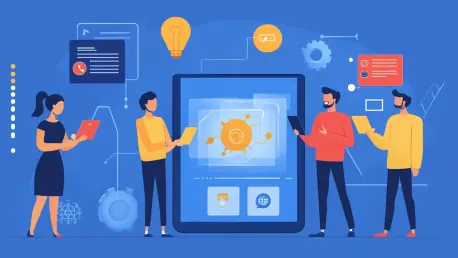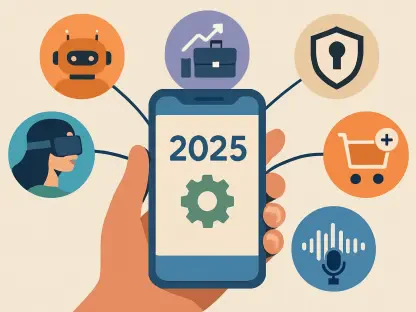Germany’s startup ecosystem is thriving, with over 568,000 startups emerging annually. Recognized globally for its supportive environment for innovation, sustainability, digital transformation, and smart mobility, Germany offers fertile ground for mobile app startups. According to McKinsey, startups in Germany are projected to contribute approximately €2.3 trillion to the economy by 2030. This article explores the top 10 high-potential mobile app ideas for startups in Germany, providing insights into market demands, development costs, and monetization strategies.
The Importance of Mobile Applications in Germany’s Digital Landscape
Driving Business Growth and Customer Engagement
In today’s competitive market, driving business growth and customer engagement requires a strategic approach involving innovative marketing techniques, excellent customer service, and leveraging technology. Businesses must continually adapt to changing consumer preferences and behaviors to stay relevant and competitive, ensuring that their growth strategies align with customer expectations and industry trends.
Mobile applications play a crucial role in driving business growth and enhancing customer engagement in Germany’s digital landscape. With German users spending an average of over 3.5 hours daily on mobile apps, the reliance on mobile technology has significantly increased, especially since the pandemic. This trend presents startups with opportunities to create apps that offer substantial value to users. By addressing various consumer needs and business challenges, mobile apps help companies establish a competitive market presence, improve service delivery, and enhance user satisfaction.
Furthermore, the adaptability and scalability of mobile applications make them an ideal solution for startups seeking rapid growth. By leveraging advanced technologies like artificial intelligence, machine learning, and big data analytics, businesses can gain valuable insights into user behavior and preferences. This information can be used to refine app functionality, deliver personalized experiences, and boost customer loyalty. Ultimately, startups that effectively harness the power of mobile applications can achieve significant growth and long-term success in Germany’s dynamic market.
Lucrative App Categories
Several app categories present lucrative opportunities for businesses in Germany. These include food delivery apps, personal care apps, FinTech and asset management apps, yard management apps, health and fitness apps, digital payment apps, educational and language learning apps, eCommerce and retail management apps, smart home and IoT apps, and tourism and local experiences apps. Each category addresses specific consumer and business needs, offering startups a chance to establish a strong market presence. By targeting these high-potential areas, entrepreneurs can tap into growing demand and meet evolving user expectations.
Moreover, the versatility of these app categories allows for the integration of innovative features and functionalities that can further enhance user experience. For instance, incorporating eco-friendly practices in food delivery apps or adding AI-driven recommendations in personal care apps can set businesses apart from competitors. As Germany continues to prioritize sustainability, digital transformation, and smart mobility, startups must focus on developing mobile applications that align with these overarching trends. By doing so, they can attract a broad user base and maximize their chances of success.
Food Delivery Apps
Simplifying Meal Ordering and Delivery
Food delivery apps have revolutionized the way people order and receive meals. These apps offer features such as real-time tracking, dietary filters, and loyalty programs, making meal ordering convenient and efficient. In Germany, where sustainability is a key focus, integrating eco-friendly packaging options or partnering with local farms can cater to the sustainability-conscious audience. Such initiatives not only help reduce environmental impact but also appeal to a growing segment of consumers who prioritize eco-friendly choices in their daily lives.
Additionally, the rise of remote work and busy lifestyles has increased the demand for convenient meal solutions. Food delivery apps that offer a wide range of cuisines, easy payment options, and swift delivery services can attract a diverse customer base. By providing a seamless experience, these apps can build strong customer loyalty and drive repeat business. Implementing user-friendly interfaces and intuitive navigation can further enhance the overall user experience, making meal ordering hassle-free and enjoyable.
Enhancing User Experience
The goal of enhancing user experience involves creating a more intuitive, engaging, and satisfying interaction for users with a product or service. By understanding user needs and preferences, businesses can design interfaces and features that are both functional and enjoyable. This holistic approach often includes improving usability, accessibility, and performance to ensure users feel valued and understood, ultimately leading to higher customer satisfaction and loyalty.
Advanced functionalities like AI-driven recommendations and personalized meal plans can enhance the user experience. By offering a seamless and personalized service, food delivery apps can attract and retain a loyal customer base, driving business growth. For example, AI algorithms can analyze user preferences, dietary restrictions, and order history to suggest meal options that align with individual tastes. Personalized meal plans can cater to specific health goals, such as weight loss or muscle gain, further increasing user satisfaction.
Moreover, incorporating gamification elements, such as reward points and challenges, can make the app more engaging and fun to use. Loyalty programs that offer discounts, exclusive deals, and special promotions can incentivize users to order more frequently. By continuously updating the app with new features, menu options, and interactive elements, startups can keep users interested and invested in the platform. Ultimately, a well-designed food delivery app that prioritizes user experience can achieve sustained growth and market success.
Personal Care Apps
Revolutionizing Self-Care
Personal care apps provide on-demand access to beauty services, wellness programs, grooming sessions, mental health assistance, and home renovation support. These apps cater to the growing demand for convenient and personalized self-care solutions. In today’s fast-paced world, individuals seek ways to prioritize their well-being without compromising their busy schedules. Personal care apps offer a solution by bringing various services to users’ fingertips, allowing them to manage their self-care routines effortlessly.
The convenience of booking appointments, accessing expert advice, and receiving personalized recommendations makes personal care apps highly appealing. Users can browse through a range of services, read customer reviews, and choose providers that best suit their needs. By offering a comprehensive platform that addresses multiple aspects of self-care, these apps can create a one-stop solution for users, saving them time and effort. As a result, personal care apps have the potential to become an essential part of users’ daily lives.
Advanced Functionalities
Incorporating advanced functionalities like virtual consultations and AI-driven recommendations can personalize user experiences. By offering tailored services, personal care apps can differentiate themselves in a competitive market and attract a diverse user base. Virtual consultations, for instance, allow users to connect with beauty experts, wellness coaches, and mental health professionals from the comfort of their homes. This level of accessibility can be particularly beneficial for individuals with busy schedules or limited mobility.
AI-driven recommendations can analyze user data, such as skin type, hair texture, and wellness goals, to suggest products and services that suit individual needs. These personalized suggestions can enhance user satisfaction and encourage continued app usage. Additionally, integrating features like appointment reminders, progress tracking, and feedback mechanisms can further improve the user experience. By continuously evolving and adapting to user needs, personal care apps can maintain a loyal customer base and achieve sustained growth in the market.
FinTech & Asset Management Apps
Simplifying Wealth and Asset Management
FinTech and asset management apps simplify wealth and asset management by enabling users to track expenses, make investments, and plan for the future. These apps cater to the growing demand for efficient and secure financial management solutions. In an increasingly digital world, individuals seek tools that can help them manage their finances conveniently and effectively. FinTech apps provide a platform for users to monitor their financial health, set budget goals, and make informed investment decisions.
By consolidating various financial services into a single app, startups can offer a comprehensive solution that meets diverse user needs. Features like real-time expense tracking, automated savings plans, and personalized investment advice can empower users to take control of their finances. Additionally, integrating educational resources and financial literacy tools can help users build a strong foundation of knowledge, making them more confident in their financial decisions. Overall, FinTech and asset management apps can play a crucial role in promoting financial well-being and security.
Leveraging Advanced Technologies
Incorporating advanced technologies like AI and blockchain can enhance security and provide personalized financial insights. By offering innovative and secure solutions, FinTech apps can build trust and attract a wide range of users. AI algorithms can analyze user spending patterns, investment behavior, and risk tolerance to offer tailored financial advice and recommendations. This level of personalization can help users achieve their financial goals more effectively.
Blockchain technology, on the other hand, can enhance the security and transparency of financial transactions. By leveraging decentralized ledgers and encryption techniques, FinTech apps can protect user data and prevent fraudulent activities. Additionally, integrating features like biometric authentication and multi-factor verification can further bolster security. By prioritizing user safety and offering cutting-edge solutions, FinTech and asset management apps can establish a strong market presence and foster long-term user trust.
Yard Management Apps
Enhancing Logistics and Supply Chain Efficiency
Yard management apps enhance logistics and supply chain efficiency by automating processes like inventory tracking, vehicle scheduling, and dock assignments. These apps are particularly valuable in Germany’s industrial landscape, where optimizing supply chain operations is crucial. In a country known for its manufacturing prowess and export-oriented economy, efficient logistics management can significantly impact overall productivity and profitability. Yard management apps offer a solution by streamlining complex processes and reducing the potential for errors and delays.
By providing real-time visibility into inventory levels, vehicle movements, and dock availability, yard management apps enable businesses to make informed decisions and improve operational efficiency. Features like automated alerts, route optimization, and load balancing can further enhance the effectiveness of logistics management. As a result, companies can achieve faster turnaround times, reduced costs, and better resource utilization. In a competitive industrial environment, these benefits can give businesses a significant edge over their rivals.
Streamlining Operations
By streamlining operations and reducing manual tasks, yard management apps can improve productivity and reduce costs. This makes them an attractive solution for businesses looking to enhance their logistics and supply chain management. Automation of routine tasks, such as inventory updates and scheduling, allows employees to focus on more strategic activities, thereby increasing overall efficiency. Additionally, the ability to monitor and analyze key performance metrics in real-time helps businesses identify areas for improvement and implement corrective measures promptly.
Furthermore, integration with other enterprise systems, such as warehouse management and transportation management systems, can create a seamless flow of information across the supply chain. This holistic approach enables better coordination and collaboration among different departments, leading to improved overall performance. By adopting yard management apps, businesses can achieve greater agility and responsiveness, essential for staying competitive in today’s fast-paced industrial landscape.
Health and Fitness Apps
Catering to Health and Fitness Needs
Health and fitness apps cater to the growing demand for innovative health and fitness solutions. These apps offer features like personalized workout plans, nutrition tracking, and mental health resources, encouraging a healthier lifestyle. In an era where health and well-being have become top priorities for many individuals, health and fitness apps provide the tools and motivation needed to achieve fitness goals. Personalized workout plans, for instance, can be tailored to individual preferences, fitness levels, and specific health objectives, making it easier for users to stay committed to their routines.
Moreover, nutrition tracking features enable users to monitor their dietary intake, set calorie goals, and maintain a balanced diet. By offering a holistic approach to health and fitness, these apps can help users achieve a comprehensive sense of well-being. Additionally, mental health resources, such as meditation guides, stress management techniques, and virtual counseling, address the importance of mental wellness alongside physical health. By providing a wide range of features and resources, health and fitness apps can appeal to a diverse user base with varying needs and preferences.
Integrating Wearable Devices
Integrating wearable device compatibility allows users to monitor vital stats and track their progress. By offering comprehensive health and fitness solutions, these apps can attract health-conscious users and promote overall well-being. Wearable devices, such as fitness trackers and smartwatches, can provide real-time data on metrics like heart rate, sleep patterns, and activity levels. By syncing this data with health and fitness apps, users can gain a more accurate and detailed understanding of their health status.
Additionally, the integration of wearable devices enables continuous monitoring and personalized feedback. For example, users can receive alerts to stay active during prolonged periods of inactivity or adjust their workout intensity based on heart rate data. These insights can help users make informed decisions about their health and fitness routines, leading to better outcomes. Furthermore, the convenience of having all health-related information in one place simplifies the process of tracking progress and setting new goals. As a result, health and fitness apps that integrate wearable devices can enhance user engagement and drive long-term adherence to healthy habits.
Digital Payment Apps
Facilitating Secure Transactions
Digital payment apps offer users a fast and hassle-free payment experience, facilitating secure transactions for in-store, online, or peer-to-peer payments. Startups can tap into this growing market segment by creating a super app that combines multiple services, such as UPI-based payments and QR code scanning. In an increasingly digital world, consumers seek convenient and secure payment solutions that streamline their financial transactions. Digital payment apps address this need by providing a user-friendly interface and a range of payment options.
The rise of eCommerce, contactless payments, and digital banking has further fueled the demand for digital payment apps. By offering seamless integration with online stores, physical retailers, and peer-to-peer payment platforms, these apps can create a comprehensive solution for users. Additionally, features like transaction history, spending analytics, and instant notifications enhance transparency and help users manage their finances more effectively. Startups that prioritize security and convenience can attract a wide user base and drive the adoption of digital payment solutions.
Enhancing User Convenience
By offering a seamless and secure payment experience, digital payment apps can enhance user convenience and build trust. This can drive user adoption and promote the use of digital payment solutions. Features like biometric authentication, encryption, and multi-factor verification ensure that user data is protected and transactions are secure. These security measures build trust and confidence among users, encouraging them to use the app for various financial transactions.
Moreover, the convenience of digital payment apps extends beyond payments. For instance, users can manage their bills, transfer money to friends and family, and even invest in financial products through a single platform. By offering a wide range of services, digital payment apps can become an essential part of users’ daily lives. The ability to make quick and secure payments without the need for physical cash or cards enhances the overall user experience. As digital payment apps continue to evolve, startups have the opportunity to innovate and create solutions that meet the ever-changing needs of consumers.
Educational and Language Learning Apps
New innovations in educational and language learning apps continue to revolutionize how students of all ages and backgrounds approach learning. These apps offer a wide range of interactive and engaging tools designed to cater to different learning styles and needs. From gamified learning experiences to personalized study plans, these apps provide users with the flexibility to study at their own pace and convenience.
Making Learning Accessible and Engaging
Educational and language learning apps make learning accessible and engaging by offering personalized courses, quizzes, and interactive lessons. These apps cater to the growing demand for convenient and effective learning solutions. In a world where lifelong learning is becoming increasingly important, educational apps provide a platform for users to acquire new skills, knowledge, and languages at their own pace. Interactive lessons, engaging quizzes, and gamified elements make learning enjoyable and motivate users to stay committed to their educational goals.
Moreover, personalized courses tailored to individual learning styles and preferences enhance the effectiveness of learning. Whether users are looking to improve their academic performance, learn a new language, or acquire professional skills, educational apps offer a flexible and accessible solution. By providing a wide range of subjects and learning resources, these apps can appeal to diverse user groups, including students, professionals, and hobbyists. The convenience of accessing learning materials anytime and anywhere further adds to the appeal of educational apps.
Advanced Functionalities
Incorporating advanced functionalities like AI-based progress tracking and personalized recommendations can create an immersive learning experience. By offering tailored learning solutions, these apps can attract a diverse user base and promote lifelong learning. AI algorithms can analyze user performance, learning patterns, and knowledge gaps to provide personalized feedback and recommendations. This level of customization ensures that users receive the support and guidance they need to succeed in their learning journey.
Additionally, features like virtual classrooms, live tutoring sessions, and interactive simulations can enhance the learning experience. Virtual classrooms enable users to participate in real-time discussions, collaborate with peers, and receive instant feedback from instructors. Live tutoring sessions offer personalized attention and guidance, helping users overcome learning challenges. Interactive simulations, on the other hand, provide hands-on experience and practical application of knowledge. By integrating these advanced functionalities, educational apps can create a rich and engaging learning environment that fosters continuous growth and development.
Conclusion
Germany’s startup ecosystem is booming, with over 568,000 startups sprouting up every year. Known worldwide for its favorable conditions for innovation, focus on sustainability, digital transformation, and smart mobility, Germany is ideal for mobile app startups. McKinsey estimates that by 2030, these startups will contribute roughly €2.3 trillion to the national economy. This article delves into the top 10 mobile app ideas in Germany that hold significant potential. It provides insights into what the market demands, the costs involved in app development, and various monetization strategies.
Germany’s strong support for startups has created an environment where new businesses can thrive. This is particularly true in the tech sector, where mobile app development is exploding. As digital technology becomes more integral to daily life, the demand for innovative mobile apps continues to surge. Entrepreneurs in Germany are uniquely positioned to capitalize on this trend, thanks to a robust infrastructure and access to skilled talent.
The potential for substantial economic impact cannot be overstated. Startups centered on mobile applications not only promise financial returns but also contribute to technological advancement and societal well-being. From apps that enhance productivity to those that promote sustainable living, the possibilities are vast. Whether you’re looking to develop an app or invest in one, understanding these high-potential ideas can offer a competitive edge in this dynamic market.









